 W
WThis is a list of Thai khanom, comprising snacks and desserts that are a part of Thai cuisine. Some of these dishes are also a part of other cuisines. The word "khanom", refers to snack or dessert, presumably being a compound between two words, "khao" (ข้าว), "rice" and "khnom" (หนม), "sweet". The word "khanom" in the Thai sense is snack or sweet food made from flour.
 W
WBua loi or bua loy is a Thai dessert. It consists of rice flour rolled into small balls, and cooked in coconut milk and sugar.
 W
WCendol is an iced sweet dessert that contains droplets of green rice flour jelly, coconut milk and palm sugar syrup. It is commonly found in Southeast Asia and is popular in Indonesia, Malaysia, Brunei, Cambodia, East Timor, Laos, Vietnam, Thailand, Singapore, and Myanmar. Next to the green jelly, additional toppings might be added, including diced jackfruit, sweetened red azuki beans, or durian.
 W
WCho Muang or Chor Muang, sometimes referred to as "Thai flower dumpling", is a traditional Thai savory snack. Its existence has been documented since the reign of King Rama II, where it is mentioned in the Kap He Chom Khrueang Khao Wan poem. Cho Muang is regarded as an ancient royal dish and is often recognized by its carved flower-shaped appearance and indigo coloring from the anchan flower. The steamed dumpling is formed into a flower-shape and contains either a salty or sweet filling. It is then served with lettuce, coriander and chili. The original recipe of Cho Muang contained a sweet filling and was later developed with the savory filling. The name Cho Muang means 'violet bouquet' in the Thai language. The name comes from the appearance of several flowers in a traditional plate arrangement.
 W
WA curry puff is a snack of Maritime Southeast Asian origin. It is a small pie consisting of curry with chicken and potatoes in a deep-fried or baked pastry shell. The curry is quite thick to prevent it from oozing out of the snack.
 W
WDokchok is one of the ancient Thai desserts consisting of tapioca flour, wheat flour and egg cook by frying. Thai ancestors usually made it for auspicious ceremonies. It is a Thai dessert shaped like a flower in the water. In Thai, dokchok means Pistia flower. It simply made from the plain flavor, accented by sesame, a touch of sugar for sweetness and coconut aroma.
 W
WFa gao, also called Fat pan by the Hakka, prosperity cake, Fortune cake, Cantonese sponge cake, is a Chinese steamed, cupcake-like pastry. Because it is often characterized by a split top when cooked, it is often referred as Chinese smiling steamed cake or blooming flowers. It is commonly consumed on the Chinese new year. It is also eaten on other festivals, wedding, and funerals by the Hakka people.
 W
WAngel hair, called in Portuguese Fios de ovos is a traditional Portuguese sweet food made of eggs, drawn into thin strands and boiled in sugar syrup. They are a traditional element in Portuguese and Brazilian cuisine, both in desserts and as side dishes.
 W
WAngel hair, called in Portuguese Fios de ovos is a traditional Portuguese sweet food made of eggs, drawn into thin strands and boiled in sugar syrup. They are a traditional element in Portuguese and Brazilian cuisine, both in desserts and as side dishes.
 W
WGrass jelly, or leaf jelly or herb jelly, is a jelly-like dessert eaten in East and Southeast Asia. It is created by using the Platostoma palustre plant and has a mild, slightly bitter taste. It is served chilled, with other toppings such as fruit, or in bubble tea or other drinks. Outside Asia, it is sold in Asian supermarkets.
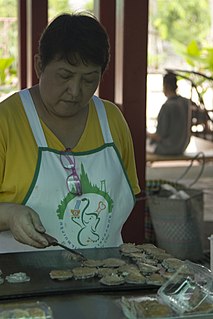 W
WKhanom babin, also spelled as kanom babin, is a popular Thai dessert that comes from Ayutthaya. It is made from young coconut, rice flour, coconut milk, sugar and egg. Nowadays, Khanom Babin is not well-known among younger generations because it is rarely found in local streets or markets.
 W
WKhanom Buang, known as Thai crepes in English. Kanom Bueang is an ancient Thai snack known as crispy pancakes in English. It is a popular form of street food in Thailand. These crepes look a bit like tacos. Khanom bueang are usually first topped or filled with meringue, followed by sweet or salty toppings such as shredded coconut, Foi Thong, or chopped scallions.
 W
WKhanom chan is an ancient Thai khanom, or dessert, made of tapioca flour, rice flour, and coconut milk, among other ingredients. Originating from the Sukhothai Period, the dessert is a staple snack in Thai cuisine, and Thai people usually prepare it for auspicious ceremonies.
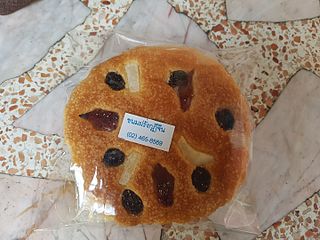 W
WKhanom farang kudi chin is a Thai-style cake that was influenced by Portuguese desserts since the Ayutthaya era, during the reign of King Narai (1633–88). Ayutthaya was a trading entrepot and had diplomatic relations with many European countries at the time, such as France, Spain, Holland and Portugal
 W
WKhanom khai hong, formerly known as khanom khai hia, is a kind of Thai dessert. It may be considered as a Thai-style doughnut balls.
 W
WKhanom khrok or coconut-rice pancakes is a traditional Thai dessert. They are prepared by mixing rice flour, sugar, and coconut milk to form a dough. Usually, khanom khrok is composed of two batters, one salty and one sweet, both of which are cooked in a heating mantle–a hot indented frying pan. After heating, khanom khrok will be picked out of the mantle and the two half-circular doughs formed into a circular shape.
 W
WKhanom khrok bai toei or Khanom khrok Singapore is a Thai dessert created by Thai people; the name khanom khrok Singapore came from one of the main ingredients, tapioca starch. Thai people formerly called tapioca flour "Singapore flour", hence khanom khrok Singapore; the word khanom means dessert in Thailand. This Thai dessert is rather hard to find at present, you only find it at some Thai dessert shops, some famous markets or department stores such as Siam Square market. Khanom khrok bai toei is shaped like a flower or a small dish, depending on the indented frying pan used to make it. It is usually a fresh green color which comes from pandan leaves. Sometimes, pastry chefs use parts of other plants instead of pandan leaves such as the blue butterfly pea flower, so this dessert can have other colors.
 W
WKhanom mo kaeng is a traditional Thai dessert. It is similar to an egg custard or a kind of flan. Khanom mo kaeng is made with coconut milk, eggs, palm sugar, white sugar, salt, shallots and a bit of oil. There are different variations of khanom mo kaeng. The kind of starch that is used is usually taros, but sometimes are used hulled mung beans, lotus seeds, sweet potatoes, or other starches.
 W
WKhanom sot sai, also known as khanom sai sai, is a Thai dessert with a sweet filling. It is made up of coconut and palm sugar, and the filling is covered with steamed rice flour mixed with coconut cream. It was used at Thai wedding ceremonies in ancient times. It is traditionally packed by wrapping in a banana leaf.
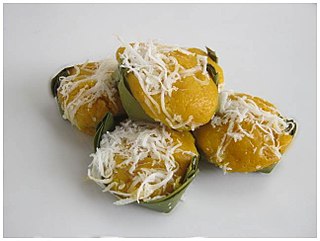 W
WKhanom tan is a local popular Thai dessert which can be found in the provinces that have sugar palm, such as Phetchaburi, Nakhon Pathom and Suphanburi.
 W
WKhanom thuai, or khanom thuai talai, is a Thai dessert made from rice flour, coconut milk and sugar. Its name is derived from the small ceramic cups in which the dessert is cooked and distinctively served, which are called thuai talai. Ingredients may also include salt, eggs and pandan essence.
 W
WKhanom Tokyo or Khanom Tokiao is a Thai street snack. It is a thin flat pancake filled with sweet custard cream. Some have a savory filling, like pork or sausage.
 W
WKhao niao sangkhaya or sticky rice with custard, is a traditional Thai dessert. It is prepared with glutinous rice, topped with coconut custard and coconut milk. Khao niao sangkhaya is served warm or at room temperature. The dessert is also found in other countries in Southeast Asia, such as Indonesia, Malaysia, Singapore, and the Philippines.
 W
WKhao tom, or Khao tom mat is a Southeast Asian dessert eaten by Laotian and Thai people, consisting of seasoned steamed sticky rice wrapped in banana leaves. Other names include Khao tom mad, Khao tom kluai, Khao tom phat, and Khao tom luk yon.
 W
WKluai buat chi or banana in coconut milk is a Thai dessert. Bananas are simply cooked in a mixture of coconut milk and coconut cream to create a flavorful dessert. Usually, Kluai buat chi is composed of two batters, one salty and one sweet, both of which are cooked in a pot.
 W
WKluai khaek, sometimes called kluai thot, is a popular Thai street snack. May be considered to be fried banana in Thai style.
 W
WKue cucur (Indonesian) or kuih cucur (Malay), known in Thai as khanom fak bua or khanom chuchun, is a traditional snack from Indonesia, and popular in parts of Southeast Asia, includes Indonesia, Malaysia, southern Thailand and Singapore. In Indonesia, kue cucur can be found throughout traditional marketplaces in the country; the popular version, however, is the Betawi version from Jakarta. In Brunei and Malaysia, the term cucur is generally used to refer to any type of fritters. A popular type of cucur in Brunei and Malaysia is Jemput-jemput and Pinjaram. In Southern Thailand, it is often featured in wedding ceremonies and festivals.
 W
WLuk chup, also spelled look choop, is a type of Thai dessert derived from marzipan, a recipe from Portugal, called massapão. The Portuguese used almonds as the main ingredient but, given the absence of almonds in Thailand, they were replaced by mung beans.
 W
WMamuang kuan, also referred to as preserved mango or mango leather, is a traditional Thai sweet. It is a preparation of dried mango in fruit leather form. Mamuang kuan's shape is slender and delicate, its texture is chewy, and its color is gold. People sometimes make the sweet into a circle, flower, or spiral.
 W
WMamuang nampla wan is a Thai snack.
 W
WMango sticky rice is a traditional Southeast Asian and South Asian dessert made with glutinous rice, fresh mango and coconut milk, and eaten with a spoon or the hands.
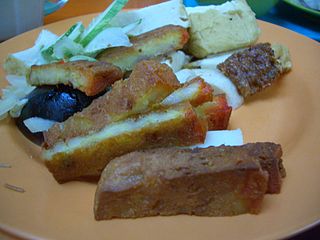 W
WNgo hiang, also known as heh gerng or lor bak is a unique Hokkien and Teochew dish widely adopted in Indonesia, Malaysia, the Philippines, Singapore, and Thailand; in addition to its place of origin in southern China.
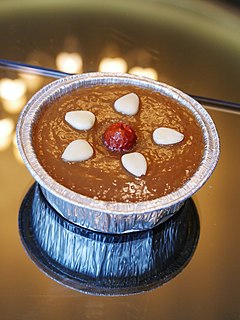 W
WNian gao, sometimes translated as year cake or New Year cake or Chinese New Year's cake, is a food prepared from glutinous rice flour and consumed in Chinese cuisine. It is also simply known as "rice cake". While it can be eaten all year round, traditionally it is most popular during the Chinese New Year. It is considered good luck to eat nian gao (年糕) during this time of the year because nian gao (年糕) is a homonym for "higher year" or "grow every year" (年高), which means "a more prosperous year". The character 年 is literally translated as "year", and the character 糕 (gāo) is literally translated as "cake" and is identical in sound to the character 高, meaning "tall" or "high". Nian gao (年糕) also has the exact homonym for "sticky cake" (粘糕); the character 粘 (nián), meaning "sticky".
 W
WThe nine auspicious Thai desserts are one of Thailand's culinary treasures. They are served on special occasions such as weddings, housewarmings, or ordinations. They confer blessings on the recipient. To deliver all the blessings at one time, the nine desserts are offered together on one tray.
 W
WO-aew is a shaved ice dessert known as a local specialty of Phuket, Thailand. Introduced by Hokkien Chinese settlers, it is known after its main ingredient, a jelly made from seeds of the o-aew plant, an ingredient now most commonly found in Taiwan where it is known as aiyu jelly.
 W
WThe prawn cracker is a form of deep fried snack made from starch and prawn. Prawn crackers are a common snack food in Southeast Asian cuisine, but they are most closely associated with Indonesia and Malaysia. They have also been adapted into East Asian cuisines.
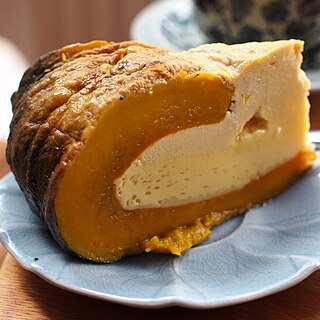 W
WPumpkin-coconut custard is a Southeast Asian dessert, consisting of a coconut custard steam-baked in a pumpkin or kabocha.
 W
WRoti sai mai is known as Ayutthaya's cotton candy. It is a Southeast Asian dessert from Thailand. It is adapted roti from the Indian subcontinent to make this dessert by wrapping floss or cotton candy in sweet roti. Roti sai mai is available at street stalls in Thailand, frequently sold by Muslim vendors.
 W
WSarim is a Thai dessert. It consists of colourful thin noodles made from mung bean flour in coconut milk and syrup, served cold with crushed ice. The dish is mentioned in the Kap He Chom Khrueang Khao Wan poem of King Rama II, though back then it was seasoned with patchouli rather than served with ice.
 W
WSiopao, is the Philippine indigenized version of the Cantonese steamed bun called cha siu bao. In Chinese, it is called baozi. It is popular to both Chinese and Filipino restaurants and it is commonly part of dim sum cuisine.
 W
WStir-fried ice cream, also known as rolled ice cream, is a sweetened frozen dessert. It is made using milk, cream and sugars as well as other added ingredients to improve the flavor. The liquid mixture is stirred to incorporate air spaces on an ice pan and simultaneously cooled to -30°C. The completed rolling process results in rolls of smooth, semisolid ice cream or gelato. The rolls are placed in a vertical position in an ice cream cup, topped off with various toppings and decorations, and eaten with a spoon.
 W
WThapthim krop is one of the best known Thai desserts, having been named one of the world's best 50 desserts by CNN Travel. It is made of cubes of water chestnuts soaked in grenadine. This dessert is known as "pomegranate seeds" or "rubies" because of its appearance. It is usually eaten with coconut milk and ice cubes.
 W
WThong ek, also known as "Wheat Flour Dumplings with Egg Yolks", is one of the nine auspicious traditional Thai desserts. It is a golden sweet carved as various types of flowers decorated with a piece of gold leaf on top, popularly served in very significant occasions such as career advancement ceremonies.
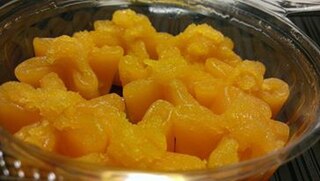 W
WThong yip, also known as "pinched gold egg yolks" in English, is one of the nine auspicious traditional Thai desserts. It is usually made for important occasions and ceremonies such as weddings, ordinations, and housewarmings. Thong yip, like many other egg-based sweets, was introduced by Japanese-Portuguese Maria Guyomar de Pinha in the reign of Somdet Phra Narai Maharat during the Ayutthaya Kingdom. Its origin is the Portuguese sweet called trouxas das caldas.
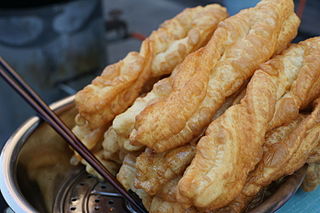 W
WYoutiao is a long golden-brown deep-fried strip of dough commonly eaten in China and in other East and Southeast Asian cuisines. Conventionally, youtiao are lightly salted and made so they can be torn lengthwise in two. Youtiao are normally eaten at breakfast as an accompaniment for rice congee, soy milk or regular milk blended with sugar. Youtiao may be known elsewhere as Chinese cruller, Chinese fried churro, Chinese oil stick, Chinese doughnut, Chinese breadstick, and fried breadstick.